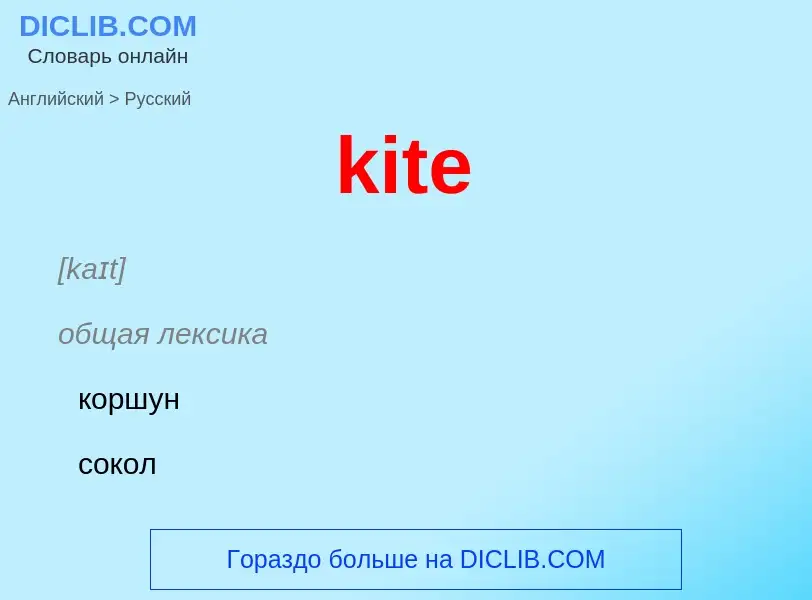Translation and analysis of words by ChatGPT artificial intelligence
On this page you can get a detailed analysis of a word or phrase, produced by the best artificial intelligence technology to date:
- how the word is used
- frequency of use
- it is used more often in oral or written speech
- word translation options
- usage examples (several phrases with translation)
- etymology
kite - translation to English
[kaɪt]
общая лексика
коршун
сокол
осоед
змейковый
коршуний
ихтиология
гладкий ромб
гладкий калкан (Scophthalmus rhombus)
разговорное выражение
младший адвокат (назначается коронным судом [crown court] для защиты подсудимого, обыкн. неимущего)
коммерция
дутый вексель
дословная передача
воздушный змей
существительное
[kait]
общая лексика
бумажный змей
пробный шар
пробный камень
верхний летучий парус
разговорное выражение
хищник
акула (о человеке)
шулер
мошенник
профессионализм
самолёт
зоология
коршун
сокол
осоед (Milvus)
жаргонизм
«дружеский вексель» (выдаётся фиктивно с тем, чтобы «кредитор» мог его учесть)
дутый вексель
фиктивный чек
не имеющий покрытия чек (выданный против неинкассированной суммы)
морской термин
плавучий якорь
синоним
глагол
общая лексика
резко повышаться
неуклонно расти
разговорное выражение
летать
парить (подобно бумажному змею)
заставлять летать
запускать (бумажный змей)
жаргонизм
получать деньги под дутый вексель
выдавать фиктивный чек (против неинкассированной суммы)
Definition
Wikipedia

A kite is a tethered heavier-than-air or lighter-than-air craft with wing surfaces that react against the air to create lift and drag forces. A kite consists of wings, tethers and anchors. Kites often have a bridle and tail to guide the face of the kite so the wind can lift it. Some kite designs don't need a bridle; box kites can have a single attachment point. A kite may have fixed or moving anchors that can balance the kite. The name is derived from the kite, the hovering bird of prey.
The lift that sustains the kite in flight is generated when air moves around the kite's surface, producing low pressure above and high pressure below the wings. The interaction with the wind also generates horizontal drag along the direction of the wind. The resultant force vector from the lift and drag force components is opposed by the tension of one or more of the lines or tethers to which the kite is attached. The anchor point of the kite line may be static or moving (e.g., the towing of a kite by a running person, boat, free-falling anchors as in paragliders and fugitive parakites or vehicle).
The same principles of fluid flow apply in liquids, so kites can be used in underwater currents. Paravanes and otter boards operate underwater on an analogous principle.
Man-lifting kites were made for reconnaissance, entertainment and during development of the first practical aircraft, the biplane.
Kites have a long and varied history and many different types are flown individually and at festivals worldwide. Kites may be flown for recreation, art or other practical uses. Sport kites can be flown in aerial ballet, sometimes as part of a competition. Power kites are multi-line steerable kites designed to generate large forces which can be used to power activities such as kite surfing, kite landboarding, kite buggying and snow kiting.


![[[Bermuda kite]] [[Bermuda kite]]](https://commons.wikimedia.org/wiki/Special:FilePath/Bermuda Kite 01.jpg?width=200)

![Woodcut print of a kite from John Bate's 1635 book ''[[The Mysteries of Nature and Art]]'' in which the kite is titled ''How to make fire Drakes'' Woodcut print of a kite from John Bate's 1635 book ''[[The Mysteries of Nature and Art]]'' in which the kite is titled ''How to make fire Drakes''](https://commons.wikimedia.org/wiki/Special:FilePath/Fier Drake (1634 kite woodcut).png?width=200)
.jpg?width=200)

![''Kite Flying'' by [[Suzuki Harunobu]], 1766 ([[Metropolitan Museum of Art]]) ''Kite Flying'' by [[Suzuki Harunobu]], 1766 ([[Metropolitan Museum of Art]])](https://commons.wikimedia.org/wiki/Special:FilePath/Kite Flying by Suzuki Harunobu (鈴木 春信).jpg?width=200)

![up or down draughts]] which cause kites to fly erratically up or down draughts]] which cause kites to fly erratically](https://commons.wikimedia.org/wiki/Special:FilePath/Man flying kite.jpg?width=200)
![Sparless [[styrofoam]] kites Sparless [[styrofoam]] kites](https://commons.wikimedia.org/wiki/Special:FilePath/Sparless Styrofoam kite in flight.jpg?width=200)
![Kathmandu]] Valley Kathmandu]] Valley](https://commons.wikimedia.org/wiki/Special:FilePath/Thrill-of-flying-kites 640.jpg?width=200)

![Making a traditional ''Wau jala budi'' kite in [[Malaysia]]. The bamboo frame is covered with plain paper and then decorated with multiple layers of shaped paper and foil. Making a traditional ''Wau jala budi'' kite in [[Malaysia]]. The bamboo frame is covered with plain paper and then decorated with multiple layers of shaped paper and foil.](https://commons.wikimedia.org/wiki/Special:FilePath/Malaysiakite.jpg?width=200)
![Various Balinese kites is on display in front of a store in [[Ubud]], Bali, Indonesia Various Balinese kites is on display in front of a store in [[Ubud]], Bali, Indonesia](https://commons.wikimedia.org/wiki/Special:FilePath/Balinese Kites 5.jpg?width=200)
![A kite shop in [[Lucknow]], India A kite shop in [[Lucknow]], India](https://commons.wikimedia.org/wiki/Special:FilePath/Kite shop in Lucknow.jpg?width=200)

![Māori]] kite Māori]] kite](https://commons.wikimedia.org/wiki/Special:FilePath/Charles-Barraud-maori-kite.jpg?width=200)

![Kites fly on top of the Mitsui Store where the craftsmen are working on top of the roof, print by [[Hokusai]] Kites fly on top of the Mitsui Store where the craftsmen are working on top of the roof, print by [[Hokusai]]](https://commons.wikimedia.org/wiki/Special:FilePath/A sketch of the Mitsui shop in Suruga street in Edo.jpg?width=200)
![[[Hiroshige II]] Enshū Akiha (1859) [[Hiroshige II]] Enshū Akiha (1859)](https://commons.wikimedia.org/wiki/Special:FilePath/Hiroshige II Enshū Akiha.jpg?width=200)
 (14749678221).jpg?width=200)

